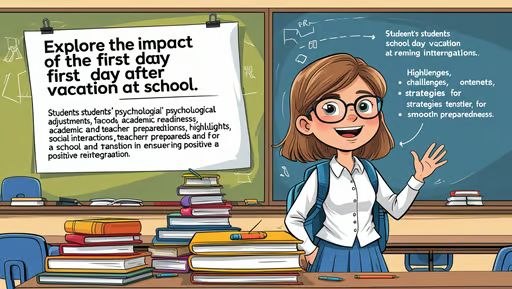Introduction
The Impact of the First Day After Vacation at School, The first day after a long vacation marks a significant transition for students, teachers, and school administrators. Whether it follows summer, winter, or a short break, returning to school brings a mix of excitement, anxiety, and adjustment challenges. The impact of this day is multifaceted, influencing student learning, teacher preparedness, and overall school dynamics. This article explores the psychological, academic, and social implications of the first day after vacation, highlighting both the benefits and challenges that schools face in managing this transition effectively.
Psychological and Emotional Impact on Students
Students experience a range of emotions on the first day back at school. Some look forward to reuniting with friends, sharing holiday experiences, and engaging in academic activities. Others may feel anxious about resuming a structured routine, dealing with academic pressure, or facing social dynamics. Younger children, particularly those in elementary school, may struggle with separation anxiety after spending an extended period with their families.
Older students, especially those in higher grades, may experience stress due to upcoming exams, assignments, or performance expectations. The transition from a relaxed vacation mindset to an academic-focused one can be abrupt, leading to lower concentration levels and reduced motivation. Schools play a critical role in easing this transition by incorporating welcoming activities, interactive sessions, and gradual reintegration into the curriculum.
Academic Adjustments and Classroom Challenges
One of the biggest challenges of the first day after vacation is reestablishing academic focus. Many students find it difficult to switch from holiday mode to structured learning. Teachers often observe a temporary decline in concentration, increased forgetfulness, and difficulty in grasping new concepts. The longer the vacation, the greater the academic lag, making it necessary for educators to implement effective strategies to bridge the learning gap.
Review sessions, interactive discussions, and engaging activities can help reignite students’ interest in learning. Educators must also assess individual student readiness and provide support where needed. The first day should not be overloaded with complex lessons but rather designed to ease students back into learning while setting the tone for the upcoming academic period.

Social Reconnection and Peer Interactions
Reconnecting with classmates is a crucial aspect of returning to school. For many students, the first day after vacation is an opportunity to socialize, share experiences, and strengthen friendships. However, it can also present challenges, particularly for those who struggle with social interactions or have experienced conflicts before the break.
Teachers can facilitate a positive social environment by organizing icebreaker activities, group discussions, and team-building exercises. Encouraging students to share their vacation experiences in a structured manner helps build a sense of community and inclusion. Additionally, addressing any social tensions or behavioral concerns early on can prevent conflicts and ensure a harmonious learning environment.
Teacher Preparedness and Classroom Management
Just as students need time to adjust, teachers also face challenges on the first day after vacation. They must prepare engaging lesson plans, manage student energy levels, and ensure a smooth transition into the academic routine. Classroom management becomes a priority, as students may exhibit excitement, restlessness, or reluctance to follow rules after a break.
Effective classroom strategies include establishing clear expectations, using engaging teaching methods, and incorporating student participation in the learning process. Teachers can also conduct informal assessments to gauge student readiness and identify areas requiring additional support. Maintaining a balance between discipline and flexibility is crucial in ensuring a productive and welcoming classroom atmosphere.
Parental Role in Transitioning Back to School
Parents play a significant role in preparing their children for the first day back at school. Establishing a structured routine before the vacation ends, such as adjusting sleep schedules and encouraging academic discussions, can ease the transition. Conversations about school expectations, goal setting, and positive reinforcement help students mentally prepare for their return.
Parental involvement in school activities, such as attending orientation sessions or communicating with teachers, also contributes to a smoother adjustment. Encouraging children to express their feelings about returning to school and addressing any concerns they may have fosters emotional readiness and confidence.
The School Environment and Administrative Support
A welcoming school environment significantly impacts students’ first-day experience. School administrators should focus on creating a positive atmosphere by organizing greeting sessions, motivational talks, and school-wide activities that encourage enthusiasm. A well-maintained, clean, and decorated school space adds to the excitement and comfort of returning students.
Administrative support extends to providing necessary resources, ensuring teacher readiness, and addressing logistical concerns such as transportation and cafeteria services. Schools that prioritize student well-being through counseling services and peer support programs create an inclusive and supportive learning environment.
Long-Term Effects on Academic Performance and Behavior
The manner in which the first day after vacation is handled can have lasting effects on students’ academic performance and behavior. A positive and structured return helps students regain focus, boost motivation, and enhance engagement. Conversely, a poorly managed transition may lead to prolonged adjustment issues, decreased interest in learning, and behavioral disruptions.
Teachers and school leaders must recognize the significance of this day and implement long-term strategies that foster continuous academic improvement and emotional well-being. Periodic check-ins, mentorship programs, and extracurricular activities help maintain student engagement throughout the term.
Conclusion
The first day after vacation is a crucial period that sets the tone for the rest of the academic term. While it presents challenges such as academic readjustment, social reintegration, and emotional fluctuations, it also offers opportunities for growth and renewed enthusiasm for learning. Schools, teachers, parents, and students must work collaboratively to ensure a smooth and positive transition. By fostering a supportive and engaging environment, the impact of the first day after vacation can be turned into a stepping stone for academic success and holistic development.

4 thoughts on “The Impact of the First Day After Vacation at School”
Comments are closed.